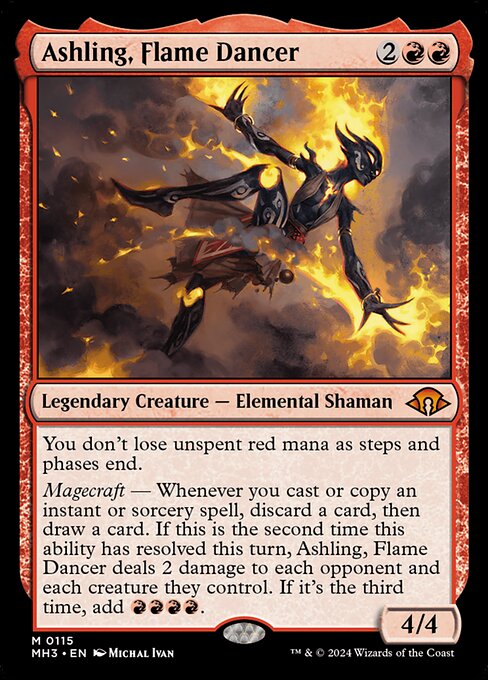
Image courtesy of Scryfall.com
Design Consistency Across Related Archetypes
Few recent Magic cards land with the same kinetic blend of risk, reward, and rhythm as Ashling, Flame Dancer. This legendary elemental shaman from Modern Horizons 3 embodies a carefully tuned design philosophy: lean into the red magecraft identity, reward players who lean into spell-slinging, and provide a path to explosive turns without stepping on the toes of other archetypes in the color pie. As a commander or a key piece in a red-focused deck, Ashling anchors a play pattern where every instant or sorcery cast or copied ripples into deeper strategic choices. 🧙♂️🔥
Ashling’s Core Identity and Why It Feels Purposeful
With a mana cost of {2}{R}{R} and a sturdy 4/4 body, Ashling immediately signals midrange to mid-to-late-game power in red. The real heartbeat, though, is the Magecraft ability: “Whenever you cast or copy an instant or sorcery spell, discard a card, then draw a card.” This is more than a refill mechanic; it’s a deliberate engine that smooths hand consistency while exposing you to the tempo of your own deck. The second time Magecraft resolves in a turn, Ashling lashes out with 2 damage to each opponent and to each creature they control. The crescendo comes on the third trigger, when you add {R}{R}{R}{R}—four red mana—to your pool. It’s a design that rewards sequencing and copy effects, turning ordinary turns into potential, edge-case blowouts. And because Ashling doesn’t make you lose unspent red mana as steps and phases end, the engine remains forgiving enough to fuel bold plays rather than punishing you for curating the perfect combo. This is red design in a single arc—fast, fiery, and decisively vocal. ⚔️💎
Maintaining Design Consistency Across Related Archetypes
Magecraft has a storied lineage in red and Izzet-aligned archetypes, acting as a bridge between card draw, tempo, and direct damage. Ashling’s trigger structure sits at a natural intersection: you want to cast or copy more spells, you want card selection to matter, and you want to turn spell slinging into real board impact. The two-part discard-and-draw cost keeps the engine honest—your intentions must be clear: what card are you exchanging, and what do you gain beyond a single spell? This mirrors other magecraft-based engines like cost-reduced draws in spell-sling shells and damage or mana acceleration that scales with repetition. The third tier of payoff—four additional red mana—fits the long-game tempo many red decks chase: a turn where you pivot from counterplay to a decisive, red-hot finish. The balance is deliberate: Ashling is a threat when you can loop through instants and sorceries, yet not so oppressive that the rest of the table can’t interact. The result is a cohesive thread that ties Ashling to a broader family of magecraft-led red archetypes, reinforcing a scannable, predictable design language across cards that celebrate the same spark. 🔥🎨
Commanding a Red Palette: How Ashling Fits in a Commander Pool
In Commander, Ashling shines as a centerpiece for spell-slinger and control-forward red builds. The interaction between card draw, discards, and damage creates a dynamic space for both proactive and reactive play. You can lean into copying spells with ways to copy both your own and opponents’ draws, turning every Magecraft trigger into practical value. Ashling’s 4/4 body is sturdy enough to pressure the board, and the escalating mana payoff on the third trigger provides a palpable "aha" moment that can define an entire game night. The artwork by Michal Ivan captures the dancer’s ferocity, aligning flavor with function—this is a red mage who moves quickly and burns bright. And yes, Modern Horizons 3’s draft-friendly design means you’ll likely encounter Ashling as a flexible pick in cube-like experiences and in casual table politics alike. 🎲🧙♂️
Practical Deckbuilding Tips: Keeping the Design Cohesive
- Prioritize reliable ways to copy spells or cast multiple instants and sorceries in a single turn to maximize Magecraft triggers.
- Balance card draw with discard in a way that keeps your hand sized for the big finish, rather than cycling into fatigue.
- Include protection and ramp that synergize with a fast-red tempo, so Ashling’s early impact translates into late-game momentum.
- Leverage the mana-energy payoff by pairing with high-impact finishers that cost a lot of red mana, ensuring you can actually spend the extra mana when the window opens.
- Keep the deck cohesive by focusing on red spell-slinging identity: keep your spells, your draws, and your threats thematically aligned for a clean, consistent game plan. ⚔️
For collectors and players who appreciate the tactile thrill of red magic, Ashling’s mythic rarity and 2024 release within Modern Horizons 3 provide a compelling design beacon. The card’s mana mechanics, stigma of risk and reward, and the satisfying crescendo of the third Magecraft trigger all contribute to a cohesive feel that resonates with fans who love the grind-and-burn cadence of red archetypes. The synergy between playstyle and flavor is a hallmark of good design, and Ashling delivers that with a confident, blazing stride. ✨
Looking to level up your on-table presentation as you blend art, strategy, and lore? Check out this product that keeps your collection protected on the go while you plan your next big magic moment:
polycarbonate card holder phone case with magsafeMore from our network
- https://blog.digital-vault.xyz/blog/post/create-canva-presentation-templates-that-look-professional/
- https://blog.digital-vault.xyz/blog/post/elevate-cinematic-poster-design-with-paper-overlays/
- https://crypto-acolytes.xyz/blog/post/reliving-greatness-the-top-snes-sports-titles-of-all-time/
- https://crypto-acolytes.xyz/blog/post/essential-minecraft-tnt-crafting-guide-quick-safe-explosions/
- https://transparent-paper.shop/blog/post/high-precision-astrometry-for-cosmology-through-a-two-kiloparsec-hot-giant/